Interventions to prevent burnout among the nurses Report 2022
Added on 2022-10-18
38 Pages8105 Words13 Views
Running head: NURSING
Interventions to prevent burnout among the nurses: A rapid review
Name of the Student
Name of the University
Author’s note
Interventions to prevent burnout among the nurses: A rapid review
Name of the Student
Name of the University
Author’s note
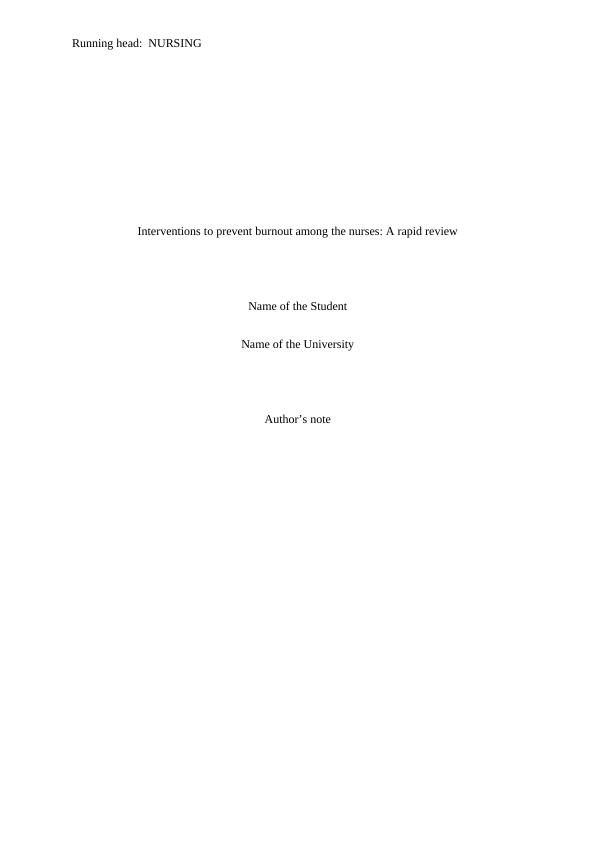
1NURSING
Executive Summary
Background: The review has been undertaken in order to evaluate the effectiveness of the
interventions that are used to control the job-related burnout among the nursing professionals
under the healthcare settings. Proper identification of the interventions used for reduction of
the job-related burnout among the nursing professionals will help to increase the overall
quality of care by decreasing the chances of the medication errors, fall related injury and
proper assessment of the patient for the identification of the clinical priority
Objective: The main objective of the study is to identify, analyse and summarize the most
effective interventions for decreasing burnout among the nursing professionals working in
hospitals. This review will be focused on the following question: “What
interventions/strategies are effective in preventing/reducing burnout among the nurses
working in health care facility?”
Inclusion criteria: Systematic reviews focusing on the burnout interventions on the
healthcare settings over the healthcare professionals. Studies published in English during the
last 10 years (2009 to 2019) are selected for the review
Types of participants: The review included nursing professionals working under the nursing
or the healthcare settings are suffering from burnout
Types of studies: Existing systematic reviews on burnout control interventions has been
identified
Types of interventions: Non-pharmacological interventions like organisational interventions,
person centred interventions and combined interventions were given included in the review
Executive Summary
Background: The review has been undertaken in order to evaluate the effectiveness of the
interventions that are used to control the job-related burnout among the nursing professionals
under the healthcare settings. Proper identification of the interventions used for reduction of
the job-related burnout among the nursing professionals will help to increase the overall
quality of care by decreasing the chances of the medication errors, fall related injury and
proper assessment of the patient for the identification of the clinical priority
Objective: The main objective of the study is to identify, analyse and summarize the most
effective interventions for decreasing burnout among the nursing professionals working in
hospitals. This review will be focused on the following question: “What
interventions/strategies are effective in preventing/reducing burnout among the nurses
working in health care facility?”
Inclusion criteria: Systematic reviews focusing on the burnout interventions on the
healthcare settings over the healthcare professionals. Studies published in English during the
last 10 years (2009 to 2019) are selected for the review
Types of participants: The review included nursing professionals working under the nursing
or the healthcare settings are suffering from burnout
Types of studies: Existing systematic reviews on burnout control interventions has been
identified
Types of interventions: Non-pharmacological interventions like organisational interventions,
person centred interventions and combined interventions were given included in the review

2NURSING
Outcomes: Reduction in the burnout among the nursing professionals through increase in the
resilience and improvement in the self-coping skills was identified as the main outcome
Search strategy: A search was done by the use of two electronic databases (MedLine and
CINHAL). The published reviews were identified based on the PICO (population,
Interventions, comparator and outcomes) components. Inclusion and exclusion criteria were
used to find reviews with similar abstract having all the required components for conducting
the review
Methodological quality: Methodological quality of the selected eight systematic reviews was
assessed by the use of AMSTAR (Assessment of Multiple Systematic Reviews). This tool os
deigned to access the methodological quality of the systematic review
Data extraction and synthesis: Data extract was done by a single person and data synthesis
was done in the narrative review format. The level of evidence of the studies was measured
through outcome measurement
Result: Among the systematic reviews present in the electronic databases, combined and
work directed interventions were found to be effective in reducing burnout among the nurses
Conclusion: Combined and work directed interventions are effective in reducing burnout
among the nurses in comparison to person-directed interventions like mindfulness based
therapy and cognitive behavioural therapy
Keywords: Burnout, occupational stress, nurses, hospital, interventions
Outcomes: Reduction in the burnout among the nursing professionals through increase in the
resilience and improvement in the self-coping skills was identified as the main outcome
Search strategy: A search was done by the use of two electronic databases (MedLine and
CINHAL). The published reviews were identified based on the PICO (population,
Interventions, comparator and outcomes) components. Inclusion and exclusion criteria were
used to find reviews with similar abstract having all the required components for conducting
the review
Methodological quality: Methodological quality of the selected eight systematic reviews was
assessed by the use of AMSTAR (Assessment of Multiple Systematic Reviews). This tool os
deigned to access the methodological quality of the systematic review
Data extraction and synthesis: Data extract was done by a single person and data synthesis
was done in the narrative review format. The level of evidence of the studies was measured
through outcome measurement
Result: Among the systematic reviews present in the electronic databases, combined and
work directed interventions were found to be effective in reducing burnout among the nurses
Conclusion: Combined and work directed interventions are effective in reducing burnout
among the nurses in comparison to person-directed interventions like mindfulness based
therapy and cognitive behavioural therapy
Keywords: Burnout, occupational stress, nurses, hospital, interventions
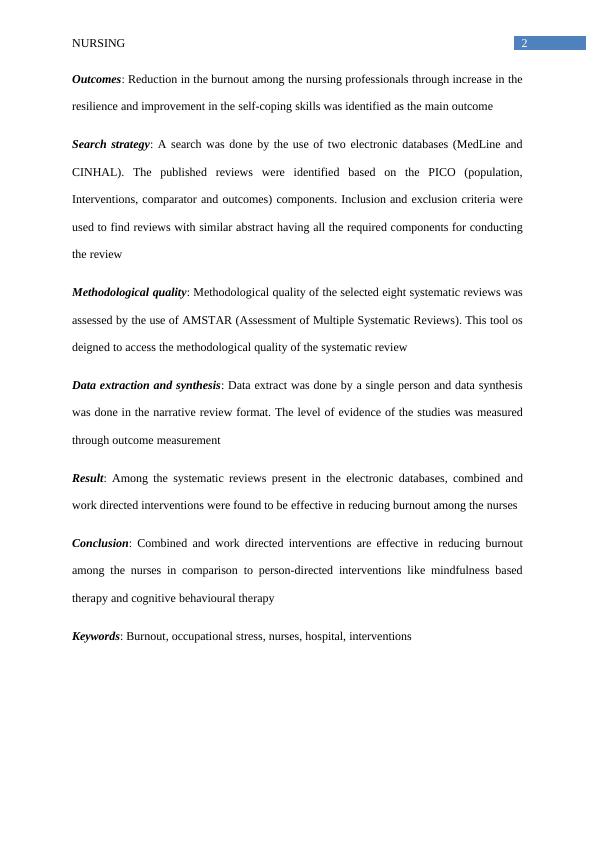
3NURSING
Table of Contents
Background................................................................................................................................4
Objective....................................................................................................................................6
Criteria for considering studies..................................................................................................6
Types of studies......................................................................................................................6
Type of participants................................................................................................................6
Type of interventions.............................................................................................................6
Search strategy...........................................................................................................................7
Methods of Review....................................................................................................................7
Assessment of methodology quality......................................................................................7
Data extraction and synthesis.................................................................................................8
Review results............................................................................................................................8
Description of the studies.......................................................................................................8
Appendix II: PRISMA.............................................................................................................10
Results......................................................................................................................................14
Quality of Systematic reviews.............................................................................................14
Summary of the Findings.....................................................................................................16
Quality of Evidence..............................................................................................................17
Potential bias in the review......................................................................................................17
Conclusion................................................................................................................................18
Implications of Practitioners....................................................................................................19
Table of Contents
Background................................................................................................................................4
Objective....................................................................................................................................6
Criteria for considering studies..................................................................................................6
Types of studies......................................................................................................................6
Type of participants................................................................................................................6
Type of interventions.............................................................................................................6
Search strategy...........................................................................................................................7
Methods of Review....................................................................................................................7
Assessment of methodology quality......................................................................................7
Data extraction and synthesis.................................................................................................8
Review results............................................................................................................................8
Description of the studies.......................................................................................................8
Appendix II: PRISMA.............................................................................................................10
Results......................................................................................................................................14
Quality of Systematic reviews.............................................................................................14
Summary of the Findings.....................................................................................................16
Quality of Evidence..............................................................................................................17
Potential bias in the review......................................................................................................17
Conclusion................................................................................................................................18
Implications of Practitioners....................................................................................................19
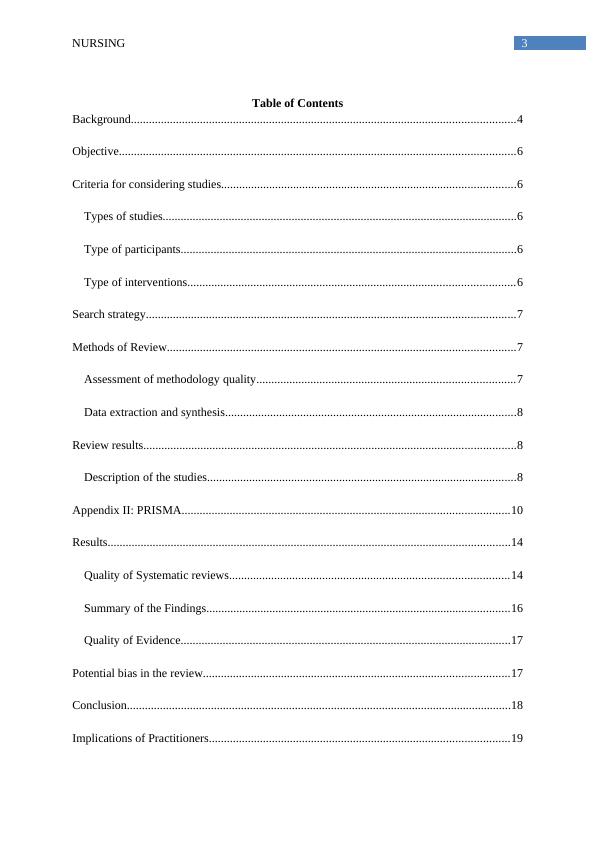
4NURSING
Implications of researchers......................................................................................................19
References................................................................................................................................20
Appendix 1...............................................................................................................................24
Search Strategy in CINHAL................................................................................................24
Appendix 2...............................................................................................................................29
Reasons for excluding studies..............................................................................................29
Appendix 4...............................................................................................................................33
Findings of the Review........................................................................................................33
Implications of researchers......................................................................................................19
References................................................................................................................................20
Appendix 1...............................................................................................................................24
Search Strategy in CINHAL................................................................................................24
Appendix 2...............................................................................................................................29
Reasons for excluding studies..............................................................................................29
Appendix 4...............................................................................................................................33
Findings of the Review........................................................................................................33

5NURSING
Background
Within occupational context, burnout is used to define a reaction of an individual
towards chronic stress in professional field. The reactions of burnout are characterized under
three-dimensional emotional consequences: emotional exhaustion (EE), depersonalization
(DP) and a sense of low personal accomplishment (PA) (Westermann et al., 2014). Burnout is
common in all profession but one of the most studied burnout is in the field of healthcare
profession (American Psychiatric Association [APA], 2018). According to Caroline et al.
(2018), burnout among the healthcare professionals is increasing now days. The symptoms of
job related burnout is caused due to increase in the level of work-related stress. Among the
healthcare professionals, nurses are the main victims of job-related burnout as they pass
through the most stressful situations during their duty time.
Nursing professionals are one of the core professionals in the healthcare sector who
spend the majority of their working hours with the patients. The increase in the expectations
of the patients and severity of the health issues of the patients increase the overall severity of
burnout among the nurses (Riberio et al., 2014). The study conducted by Chaudary and
Mujawar (2018) highlighted that the prevalence of burnout syndrome is higher among the
nurses (10.1%) and study also highlighted that nurses are 55% more vulnerable in developing
burnout syndrome in the healthcare sectors. It is estimated that the nurses who are between
the age group of 25 to 29 years are more vulnerable in getting affected with the symptoms of
job-related burnout in comparison to the tenured registered nurses. The main reasons behind
the development of burnout among the nursing professionals is increase job pressure, high
workload, extended shift hours, lack of proper encouragement and remuneration in the
workplace and over-crowed or lack or organizational safety in workplace (Adriaenssens et
al., 2015). The study conducted by Creedy, Sidebotham, Gamble, PallantandFenwick (2017)
Background
Within occupational context, burnout is used to define a reaction of an individual
towards chronic stress in professional field. The reactions of burnout are characterized under
three-dimensional emotional consequences: emotional exhaustion (EE), depersonalization
(DP) and a sense of low personal accomplishment (PA) (Westermann et al., 2014). Burnout is
common in all profession but one of the most studied burnout is in the field of healthcare
profession (American Psychiatric Association [APA], 2018). According to Caroline et al.
(2018), burnout among the healthcare professionals is increasing now days. The symptoms of
job related burnout is caused due to increase in the level of work-related stress. Among the
healthcare professionals, nurses are the main victims of job-related burnout as they pass
through the most stressful situations during their duty time.
Nursing professionals are one of the core professionals in the healthcare sector who
spend the majority of their working hours with the patients. The increase in the expectations
of the patients and severity of the health issues of the patients increase the overall severity of
burnout among the nurses (Riberio et al., 2014). The study conducted by Chaudary and
Mujawar (2018) highlighted that the prevalence of burnout syndrome is higher among the
nurses (10.1%) and study also highlighted that nurses are 55% more vulnerable in developing
burnout syndrome in the healthcare sectors. It is estimated that the nurses who are between
the age group of 25 to 29 years are more vulnerable in getting affected with the symptoms of
job-related burnout in comparison to the tenured registered nurses. The main reasons behind
the development of burnout among the nursing professionals is increase job pressure, high
workload, extended shift hours, lack of proper encouragement and remuneration in the
workplace and over-crowed or lack or organizational safety in workplace (Adriaenssens et
al., 2015). The study conducted by Creedy, Sidebotham, Gamble, PallantandFenwick (2017)
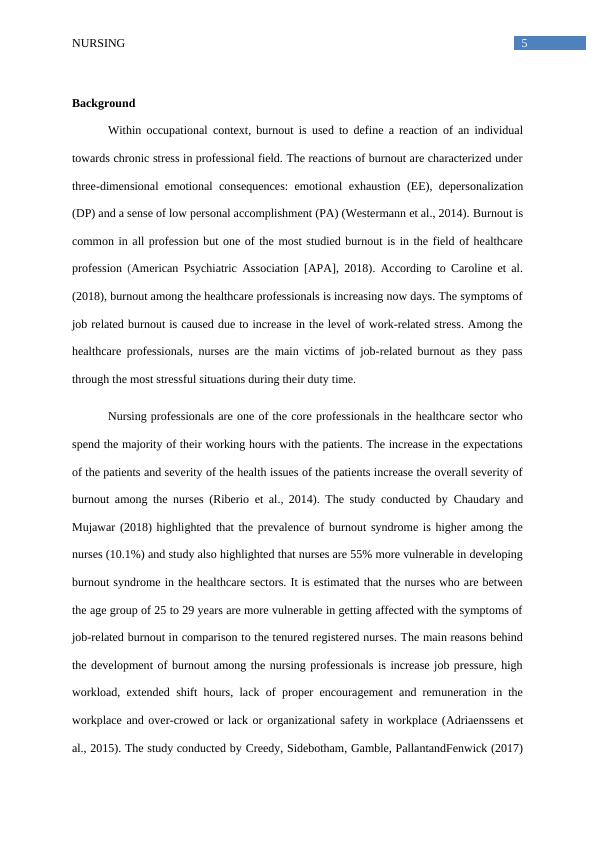
6NURSING
argued that prevalence of burnout among the Australian midwives are higher in comparison
to the nurses.
There are numerous consequences of burnout among the nursing professionals like
decrease in the overall quality of care, increase in the nurse turnover, generation of
psychological and physiological consequences among the nurses like depression, stress,
anxiety. These symptoms are associated with along with illicit drug abuse, obesity, alcohol
consumption, insomnia and musculoskeletal disorder (Salmond et al., 2017). Burnout also
increases conflict among the colleagues, hampering team work, promotes development of
aggression and absentees (Adriaenssenset al., 2015).
In order to reduce nursing burnout numerous interventions are proposed. Some of the
common interventions used to manage the symptoms of nursing burnout are educational
program for the management of emotional distress, promoting communication skills and
family-centred care. Education on coping skills, mindfulness based therapy; cognitive
behavioural therapy (CBT) and yoga are other frequently used interventions for nursing
burnout (Fong et al., 2014). Interventions are also proposed for the improvement of the
organisational work environment like social support strategies, proper team management, job
rotation (weekly) and maintaining proper workplace schedule and culture. Use of these
interventions helps in reducing in 50% to 60% of the relative risk of burnout and increase
patient satisfaction (van Mol et al., 2015).
However there is lack of evidence-based research in order to highlight the most
effective intervention for fighting against nursing burnout. Thus, the main purpose of this
rapid review is to analyse the effective interventions designed to prevent nursing burnout
prevention. This systematic review paper will conduct a narrative qualitative analysis of the
argued that prevalence of burnout among the Australian midwives are higher in comparison
to the nurses.
There are numerous consequences of burnout among the nursing professionals like
decrease in the overall quality of care, increase in the nurse turnover, generation of
psychological and physiological consequences among the nurses like depression, stress,
anxiety. These symptoms are associated with along with illicit drug abuse, obesity, alcohol
consumption, insomnia and musculoskeletal disorder (Salmond et al., 2017). Burnout also
increases conflict among the colleagues, hampering team work, promotes development of
aggression and absentees (Adriaenssenset al., 2015).
In order to reduce nursing burnout numerous interventions are proposed. Some of the
common interventions used to manage the symptoms of nursing burnout are educational
program for the management of emotional distress, promoting communication skills and
family-centred care. Education on coping skills, mindfulness based therapy; cognitive
behavioural therapy (CBT) and yoga are other frequently used interventions for nursing
burnout (Fong et al., 2014). Interventions are also proposed for the improvement of the
organisational work environment like social support strategies, proper team management, job
rotation (weekly) and maintaining proper workplace schedule and culture. Use of these
interventions helps in reducing in 50% to 60% of the relative risk of burnout and increase
patient satisfaction (van Mol et al., 2015).
However there is lack of evidence-based research in order to highlight the most
effective intervention for fighting against nursing burnout. Thus, the main purpose of this
rapid review is to analyse the effective interventions designed to prevent nursing burnout
prevention. This systematic review paper will conduct a narrative qualitative analysis of the
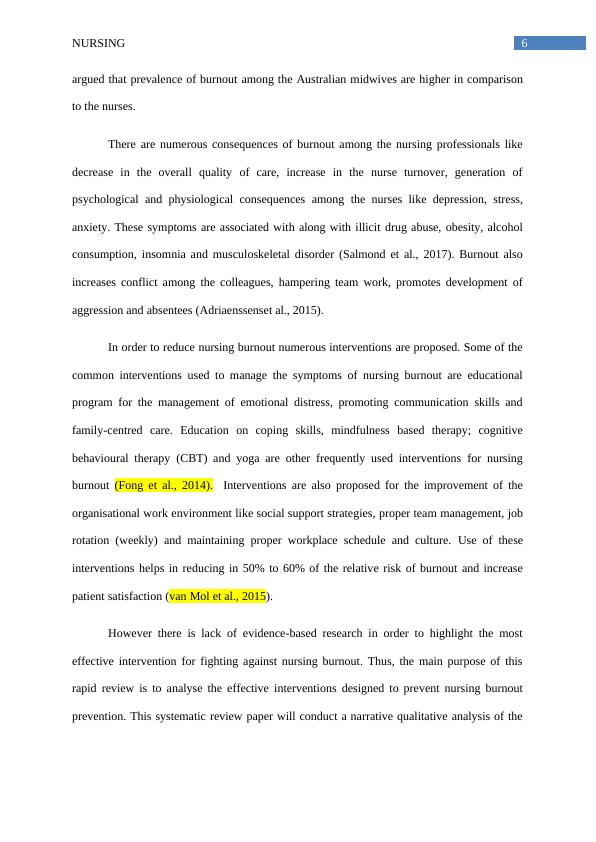
7NURSING
systematic review articles in order to come to a conclusion of important evidence-based
practice for fighting against nursing burn-out symptoms.
Objective
The purpose of this rapid review is to identify, analyse and summarize the most
effective interventions for reducing burnout among the nurses working in health care facility.
This review focus on the following question: “What interventions/strategies are effective in
preventing/reducing burnout among the nurses working in health care facility?”
Criteria for considering studies
Types of studies
The rapid review was conducted by focusing on the systematic review articles that are
published during the last 10 years (2009 to 2019). The selection of the paper was based on the
strategies discussed in the research article in order to overcome nursing burnout.
Type of participants
The main participants of focus during the selection of the systematic reviews were
registered nurses (RN) and enrolled nurses (EN).
Type of interventions
This review included any intervention those are intended to reduce and prevent
burnout among nurses. The interventions include physical and psychological like educational
intervention, occupational therapy, workplace interventions, yoga and mindfulness based
therapy and cognitive behavioural therapy
Types of Outcome
systematic review articles in order to come to a conclusion of important evidence-based
practice for fighting against nursing burn-out symptoms.
Objective
The purpose of this rapid review is to identify, analyse and summarize the most
effective interventions for reducing burnout among the nurses working in health care facility.
This review focus on the following question: “What interventions/strategies are effective in
preventing/reducing burnout among the nurses working in health care facility?”
Criteria for considering studies
Types of studies
The rapid review was conducted by focusing on the systematic review articles that are
published during the last 10 years (2009 to 2019). The selection of the paper was based on the
strategies discussed in the research article in order to overcome nursing burnout.
Type of participants
The main participants of focus during the selection of the systematic reviews were
registered nurses (RN) and enrolled nurses (EN).
Type of interventions
This review included any intervention those are intended to reduce and prevent
burnout among nurses. The interventions include physical and psychological like educational
intervention, occupational therapy, workplace interventions, yoga and mindfulness based
therapy and cognitive behavioural therapy
Types of Outcome
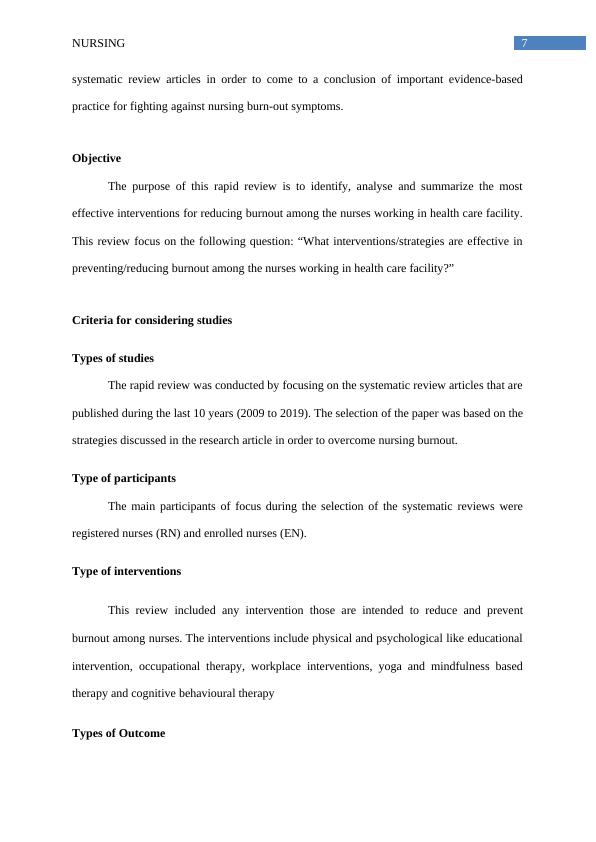
End of preview
Want to access all the pages? Upload your documents or become a member.
Related Documents
Effectiveness of 1:1 Nurse Patient Ratio: A Rapid Reviewlg...
|46
|9783
|84
Effectiveness of Psychological Support Strategies for Cancer Patientslg...
|48
|11028
|26
MRI In Breast Cancer Screening Rapid Review Case Study 2022lg...
|38
|8150
|86
Systematic Review: Experience of International Nursing Studentslg...
|33
|6045
|338
Interventions for Pressure Ulcer Preventionlg...
|35
|7131
|148
Effective Interventions for Preventing Childhood Obesity in School Age Childrenlg...
|38
|7007
|45
